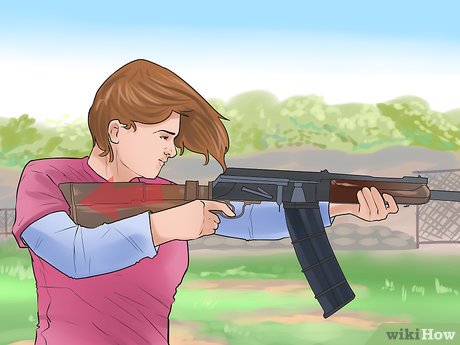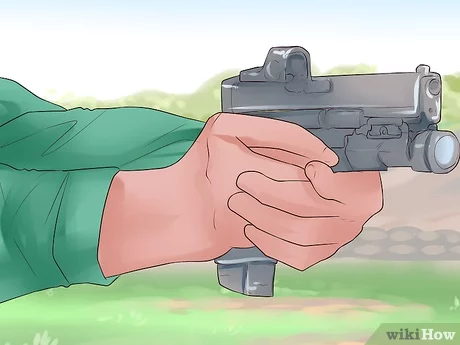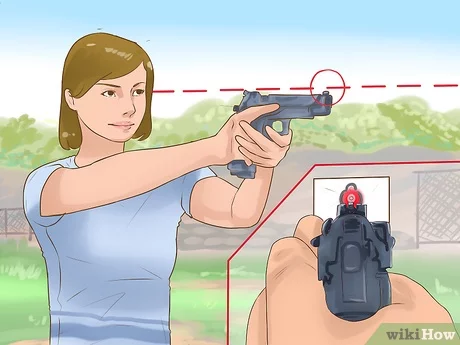If you are interested in learning how to shoot a pistol, you have come to the right place! Pistol shooting can be a fun and challenging hobby, or you can use it for self-defense.
This blog post will discuss the basics of shooting a pistol and provide some tips to help you improve your accuracy.
Whatever your reasons for wanting to learn how to shoot a pistol may be, we hope that this blog post will help you get started!
Why Can Pistols Be difficult to Shoot?
There are several reasons why pistols can be difficult to shoot. One reason is that they have a relatively short barrel, making them difficult to control. Another reason is that they tend to have high recoil, making them difficult to control.
Pistols can be challenging to shoot because they require a high degree of accuracy and precision. They also have a relatively short range, so you have to be very close to your target to hit it.
Additionally, pistols typically have a small magazine capacity, so you have to reload them frequently.
Finally, pistols can be difficult to control, particularly if you are not used to shooting them. If you are not careful, you can quickly fire more rounds than you intended or hit something other than your target.
How to shoot a pistol?

There are four basic steps to shooting a pistol:
Grip the gun correctly.
Aim the gun.
Press the trigger.
Follow through.
Let’s take a closer look at each of these steps.
1. Grip the gun correctly
Place your strong hand on the gun’s grip and wrap your fingers around it, keeping your index finger above the trigger guard and alongside the gun’s frame. Use your other hand to support the gun by holding it underneath the barrel, keeping your fingers clear of the trigger area.
This is known as a two-handed grip and will help you keep the gun stable when firing. The proper grip will provide you with a good lateral balance and ensures gun safety. One huge advantage is to maintain a tight grip and don’t let all the shot breaks.
Be sure to grip the gun with your strong hand, and keep your finger off the trigger until you are ready to shoot. Also, be aware of where the muzzle is pointing at all times. Keep it pointed in a safe direction, and never point it at anything you don’t want to shoot.
2. Aim the gun
Aim by aligning the front and rear sights of the gun. The front sight is typically a dot or a bead, while the rear consists of two notches.
Line up the front sight so that it is in between the two notches in the rear sight, with the top of the front sight level with the top of the rear sight. This will help you to keep your shots accurate.
3. Press the trigger
Slowly and smoothly press the trigger finger until the gun fires. Do not jerk or pull the trigger, as this can cause you to miss your target.
Be sure to take care when handling any firearm and always point the gun in a safe direction, even when you do not intend to shoot it.
Never put your finger on the trigger pulls until you are ready to fire the gun. When you have finished shooting, always unload the gun and safely store it away. Never put the gun on the very tip of the finger.
4. Follow through
Once you have fired the gun, continue to hold it steady for a moment before lowering it. This will help you to maintain your aim and improve your accuracy.
Practice these steps at a shooting range until you are comfortable with them. Then, you will be ready to shoot a pistol like a pro! These steps are also applicable to dry fire.
Rules for safe pistol handling and shooting

There is always a risk when shooting or dropping a cocked gun without proper sight picture and alignment. Here are the detailed rules!
-
Always keep the gun pointed in a safe direction.
-
Treat every gun as if it were loaded.
-
Keep your finger off the trigger until you are ready to shoot.
-
Be sure of your target and what is beyond it.
-
Use proper ammunition for your gun.
-
Keep the action open and unloaded until ready to use.
-
Never point a gun at anyone unless you intend to shoot them
-
Do not shoot at hard surfaces or water; the bullet could ricochet and hit someone nearby
-
Store guns and ammunition safely, out of the reach of children and other unauthorized persons
-
Seek professional help if you have difficulty coping with anger, stress, or other emotions that might lead you to mishandle a gun.
-
Get instruction from a certified firearms instructor before handling or shooting any gun.
-
Never use drugs or alcohol before or while handling or shooting guns.13. Never hold a gun while you are angry, upset, or in other emotional states that might lead to careless or accidental discharge.
-
If you see someone handling a gun carelessly or recklessly, report it to the authorities immediately.
-
Be familiar with your gun and how it works before using it.
-
Always wear ear and eye protection when shooting for firearm safety
-
Remember that the rules also apply to dry firing
-
Learn and follow all local, state, and federal laws regarding firearms ownership, storage, and use.
Handgun-Shooting Techniques
Handgun-shooting techniques can be broadly divided into target shooting and combat shooting. Target shooting is typically done at static paper or steel targets at varying distances, while combat shooting usually involves moving targets and shorter engagement distances.
Whether you’re interested in competitive marksmanship or self-defense, there are basic principles of good technique that will help you shoot more accurately.
You may also like: Spotting Scope for Target Shooting Review
Stance
Your stance is the foundation of good shooting techniques. A stable platform will help you make more accurate shots, while an unstable platform will make it difficult to hit your target consistently.
There are many different ways to stand when shooting a handgun, but the most important is finding a stance that works for you and is comfortable. Some common stance options include:
Isosceles Stance:
The most popular stance among competitive shooters, the Isosceles places your feet shoulder-width apart and points your toes forward.
Both arms are extended straight out before you, forming an isosceles triangle with your torso and the gun.
Weaver Stance:
Named after Los Angeles police officer Jack Weaver, who developed it in the 1950s, the Weaver uses a slightly different body position than the Isosceles.
Your strong-side foot is placed slightly behind your weak-side foot, and your hips are turned slightly to the weak-side.
Both arms are extended, with the gun hand pushing forward and the support hand pulling back.
Chapman Stance
Developed by famed firearms instructor Ray Chapman, this stance is similar to the Weaver but starts from a square position.
Both feet are placed shoulder-width apart, and your hips and shoulders are squared up to the target. The gun arm is extended straight out, while the support arm is bent at a 90-degree angle.
Grip

Your grip is critical to shooting accurately. A good grip will help you control the gun’s recoil, keep the sights aligned with the target, and shoot more consistently. There are many different ways to grip a handgun, but the most important thing is finding a comfortable grip that gives you good control of the gun.
Some common grip options include:
Two-Handed Grip
The most popular grip among shooters, the two-handed grip, uses both hands to hold the gun. The strong hand grips the gun near the bottom of the handle, while the support hand wraps around the strong hand. The fingers of both hands should be interlocked.
One-Handed Grip
This grip is typically used when shooting at close range or when only one hand is available.
The gun is gripped with just a strong hand, with the fingers wrapped around the handle. The thumb should be placed on top of the weapon, not wrapped around the handle.
Thumb-Over-Barrel Grip
This grip is similar to the two-handed grip. However, the support hand is placed over the top of the gun instead of underneath.
This grip can give you more control of the gun, but it can also block your view of the front sight.
Trigger Control
One of the most important aspects of shooting accurately is trigger control. Proper trigger control will help you maintain good sight alignment and hit more consistently.
There are a few key things to keep in mind when working on your trigger control:
Take up the slack in the trigger before firing. This ensures that you’re pulling the trigger straight back and not disturbing your sight alignment.
Squeeze the trigger slowly and evenly. A smooth, consistent trigger pull will help you maintain good sight alignment and shoot more accurately.
Follow through after the shot. Keep your finger on the trigger until the gun has finished recoil and is back on target. This will help you stay on target and be ready for a follow-up shot.
Sight Alignment
Proper sight alignment is critical to shooting accurately. The front sight should be aligned with the rear sights, and all three should be centered on the target.
There are a few things to keep in mind when aligning your sights:
-
The top of the front sight should be level with the top of the rear sights.
-
The front sight should be centered in the rear sights.
-
Both front and rear sights should be centered on the target.
Breath control
Breathing plays a significant role in shooting accurately. When you breathe, your body moves and can throw off your aim.
The key is to take a deep breath and let it out slowly, exhaling until you’re at the point where your body is relaxed and not moving. Then, take the shot.
Follow through
Follow-through is just as important as any other step in the shooting process. Once you’ve squeezed the trigger, don’t move the gun until the shot is complete.
This includes the recoil and returns to the target. Following through will help you stay on target and ready for a follow-up shot.
How does gun range matter?
It has been said that the average gun owner only visits the range a few times a year. So, how important is it to have a gun range close by if this is true? After all, if you only go to the range a few times a year, it surely doesn’t matter too much how far away it is, right?
Wrong. Your gun range’s location can significantly impact how often you visit it and, ultimately, how proficient you are with your firearm.
The first thing to consider is the time commitment required to get to your gun range. If it’s an hour drive each way, then that’s two hours that you could be spending at the range instead of driving. And let’s be honest, most of us would rather be shooting our guns than sitting in traffic.
The second thing to consider is the cost of ammunition. If you have to drive an hour to get to the range, you’re probably going to want to buy a lot of ammo to make the most of your time there. But if the gun range is close by, you can just buy a few boxes and still get in some good trigger time.
The third thing to consider is the quality of the gun range itself. If it’s clean, well-lit, and has good target options, then you’re much more likely to enjoy your time there and want to come back. But if it’s dirty, dark, and the only targets are old soda cans, you’re probably not going to have a very good time.
So, in short, gun range location does matter. It’s important to find a gun range close by with good amenities. Otherwise, you might make excuses not to go as often as possible.
Pistol Shooting Tips for a More Accurate Shot
When it comes to accuracy, practice makes perfect. The following tips can help you improve your shooting skills and accuracy:
Use a Proper Grip
How you grip the pistol is vital for accuracy. You want to make sure that you have a firm grip on the gun but not too tight that your hand starts to shake. A good grip will help keep the gun steady as you take your shot.
Find Your Sight Picture
Taking the time to line up your sights correctly will help improve your accuracy. Ensure that you are looking through the sights and not just aiming in the target’s general direction.
Take Your Time
Don’t rush your shots. If you can, take a deep breath and let it out slowly before squeezing the trigger. This will help you relax and focus on taking a well-aimed shot.
Practice, Practice, Practice
As with anything, the more you practice, the better you will become at shooting. If possible, try to find a local gun range where you can get in some target practice. Shooting at different distances and angles will help improve your overall accuracy.
Conclusion
While this guide is by no means comprehensive, it should give you a basic understanding of how to shoot a pistol. Remember always to practice safe gun handling procedures and consult with an experienced shooter before taking your pistol shooting for the first time. Whether you’re a first-timer or an experienced shooter, these tips will help you hit your target.
You may also like: Budget Pistol Lights
stayontrails
Latest posts by stayontrails (see all)
- How To Bike Uphill Without Getting Tired - May 12, 2022
